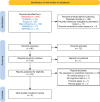The effect of dual-task conditions on postural control in adults with low back pain: a systematic review and meta-analysis
- PMID: 37528400
- PMCID: PMC10391969
- DOI: 10.1186/s13018-023-04035-6
The effect of dual-task conditions on postural control in adults with low back pain: a systematic review and meta-analysis
Abstract
Background: Dual-task conditions, which involve performing two tasks simultaneously, may exacerbate pain and further impair daily functioning in individuals with low back pain (LBP). Understanding the effects of dual-task conditions on postural control in patients with LBP is crucial for the development of effective rehabilitation programs. Our objective was to investigate the impact of dual-task conditions on postural control in individuals with LBP compared to those without LBP.
Methods: We conducted a comprehensive search of Medline via PubMed, Scopus, the Cochrane Central Register of Controlled Trials, Web of Science, and EMBASE databases, with no language restrictions, from inception to January 1, 2023. The primary outcome measures of the study were velocity, area, amplitude, phase plane portrait, and path/sway length of the center of pressure (CoP). Standardized mean difference (SMD) effect sizes were calculated, and the quality of the studies was assessed using the Newcastle-Ottawa Scale (NOS).
Results: From 196 studies, five involving 242 adults (≥ 18 years) met the inclusion criteria. Three studies were rated as high quality, while two were deemed moderate. In the included studies, 140 participants had non-specific LBP, while 102 participants did not report any symptoms, with mean ages of 36.68 (± 14.21) and 36.35 (± 15.39) years, respectively. Three studies had both genders, one exclusively included females, and one did not specify gender. Meta-analyses of primary outcomes revealed no significant differences in postural control between patients with LBP and pain-free controls during both easy and difficult postural tasks and cognitive load for velocity (easy: SMD - 0.09, 95% CI - 0.91 to 0.74; difficult: SMD 0.12, 95% CI - 0.67 to 0.91), area (easy: SMD 0.82, 95% CI - 2.99 to 4.62; difficult: SMD 0.14, 95% CI - 2.62 to 2.89), phase plane (easy: SMD - 0.59, 95% CI - 1.19 to 0.02; difficult: SMD - 0.18, 95% CI - 0.77 to 0.42), path/sway length (easy: SMD - 0.18, 95% CI - 0.77 to 0.42; difficult: SMD - 0.14, 95% CI - 0.84 to 0.55), and amplitude (easy: SMD 0.89, 95% CI - 1.62 to 3.39; difficult: SMD 1.31, 95% CI - 1.48 to 4.10).
Conclusions: The current evidence suggests that there are no significant differences in postural control parameters during dual-task conditions between individuals with non-specific LBP and pain-free subjects. However, due to the limited number of available studies, significant publication bias, and considerable statistical heterogeneity, definitive conclusions cannot be drawn. Therefore, further research comprising high-quality studies with larger sample sizes is necessary to obtain conclusive results. Trial registration PROSPERO CRD42022359263.
Keywords: Center of pressure; Dual task; Low back pain; Postural balance; Systematic review.
© 2023. The Author(s).
Conflict of interest statement
The authors declare no competing interest exists.
Figures





Similar articles
-
Multidisciplinary biopsychosocial rehabilitation for subacute low back pain.Cochrane Database Syst Rev. 2017 Jun 28;6(6):CD002193. doi: 10.1002/14651858.CD002193.pub2. Cochrane Database Syst Rev. 2017. PMID: 28656659 Free PMC article.
-
Yoga treatment for chronic non-specific low back pain.Cochrane Database Syst Rev. 2017 Jan 12;1(1):CD010671. doi: 10.1002/14651858.CD010671.pub2. Cochrane Database Syst Rev. 2017. Update in: Cochrane Database Syst Rev. 2022 Nov 18;11:CD010671. doi: 10.1002/14651858.CD010671.pub3. PMID: 28076926 Free PMC article. Updated.
-
Educational interventions for the management of cancer-related fatigue in adults.Cochrane Database Syst Rev. 2016 Nov 24;11(11):CD008144. doi: 10.1002/14651858.CD008144.pub2. Cochrane Database Syst Rev. 2016. PMID: 27883365 Free PMC article.
-
Interventions for treating persistent pain in survivors of torture.Cochrane Database Syst Rev. 2017 Aug 18;8(8):CD012051. doi: 10.1002/14651858.CD012051.pub2. Cochrane Database Syst Rev. 2017. PMID: 28820231 Free PMC article.
-
Technological aids for the rehabilitation of memory and executive functioning in children and adolescents with acquired brain injury.Cochrane Database Syst Rev. 2016 Jul 1;7(7):CD011020. doi: 10.1002/14651858.CD011020.pub2. Cochrane Database Syst Rev. 2016. PMID: 27364851 Free PMC article.
Cited by
-
Association of resting-state EEG with suicidality in depressed patients: a systematic review.BMC Psychiatry. 2025 Jan 7;25(1):24. doi: 10.1186/s12888-024-06464-x. BMC Psychiatry. 2025. PMID: 39773698 Free PMC article.
-
Efficacy of Sensor-Based Training Using Exergaming or Virtual Reality in Patients with Chronic Low Back Pain: A Systematic Review.Sensors (Basel). 2024 Sep 27;24(19):6269. doi: 10.3390/s24196269. Sensors (Basel). 2024. PMID: 39409307 Free PMC article.
-
Physiotherapeutic and non-conventional approaches in patients with chronic low-back pain: a level I Bayesian network meta-analysis.Sci Rep. 2024 May 21;14(1):11546. doi: 10.1038/s41598-024-62276-9. Sci Rep. 2024. PMID: 38773302 Free PMC article.
-
Answer to the Letter to the Editor of M. Hamza, et al. concerning "Implications for fall efficacy strategies on center of pressure and center of gravity sway distances in adults with chronic low back pain" by P.S. Sung, et al. (Eur Spine J [2024]: doi: 10.1007/s00586-024-08523-z).Eur Spine J. 2025 Feb;34(2):797-799. doi: 10.1007/s00586-024-08606-x. Epub 2024 Dec 26. Eur Spine J. 2025. PMID: 39724429 No abstract available.
References
-
- Jensen AJ, Andersen JH, Christiansen DH, Seidler A, Dalbøge A. O-110 association between occupational mechanical exposures and chronic low back pain: a systematic review and meta-analysis. Occup Environ Med. 2023;80:A60–A60.
-
- Ansari S, Sharma S, Kumar S, Sharma S. Effect of stabilization exercises on balance parameters in chronic low back pain: a systematic review. Sport Sci Health. 2022;18:603–619. doi: 10.1007/s11332-021-00864-2. - DOI
Publication types
MeSH terms
LinkOut - more resources
Full Text Sources
Miscellaneous

